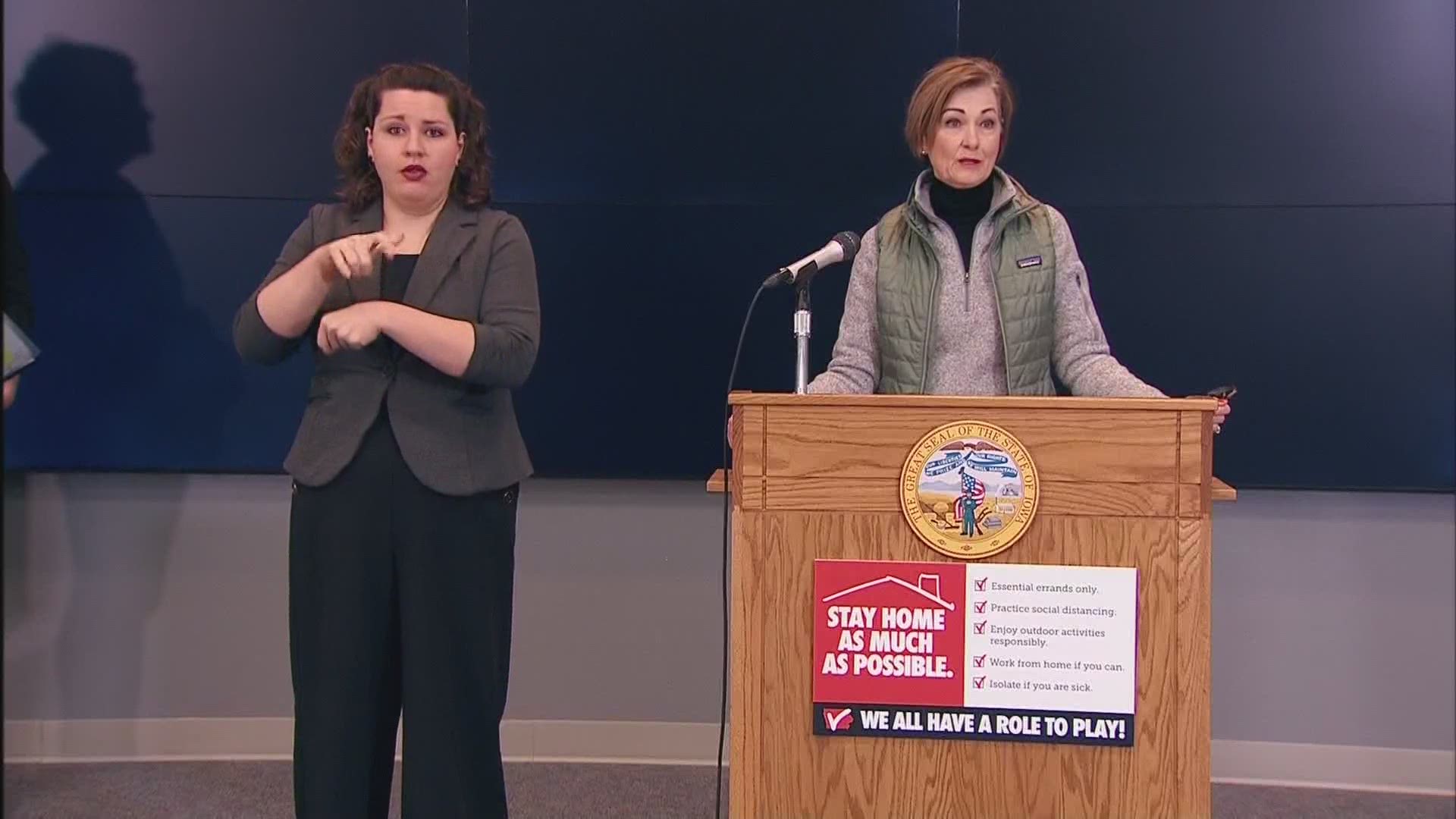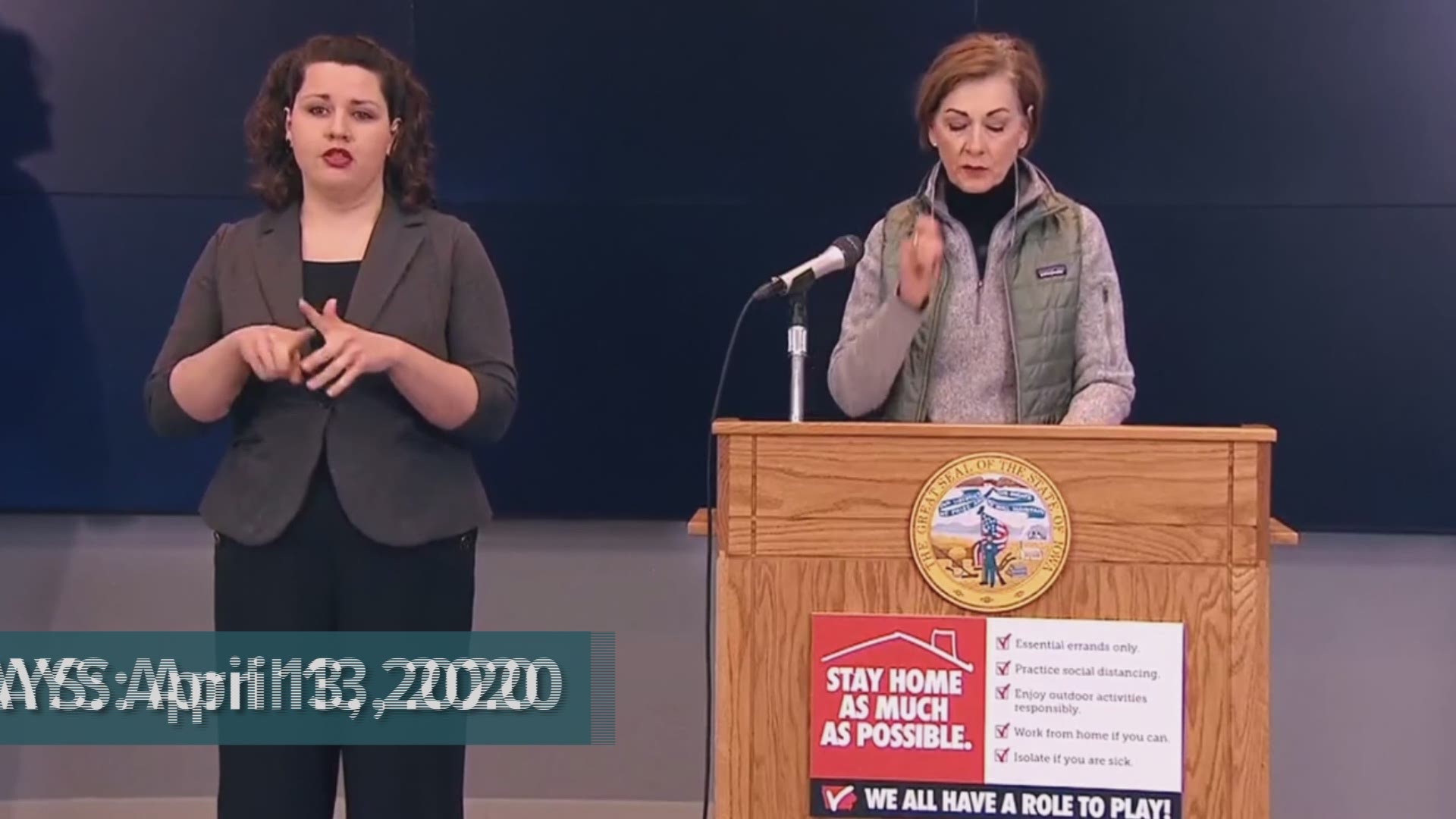DES MOINES, Iowa — Gov. Kim Reynolds announced an additional 123 positive cases of COVID-19, reaching the statewide total of 1,710.
Cass County is the latest to be added to the list of counties with positive cases. According to the Iowa Department of Public Health, 82 of Iowa's 99 counties now have positive cases.
Negative tests total to 16,986 in the state. Reynolds said 981 negative tests came back Monday, and that the State Hygienic Lab is able to test 3,565 Iowans.
142 Iowans are hospitalized from the virus as of Sunday night.
741 Iowans have recovered, leaving Iowa's recovery rate at 43%.
Two more Iowans have died from COVID-19 complications: an elderly adult (81+) from Linn County and an older adult (61-80) from Muscatine County.
Reynolds also gave an update on Regional Medical Coordination Centers (RMCCs) in the state.
RMCCs are a resource for health care providers during this time. In short, they help facilitate multi-agency and civilian-partner communication, critical information sharing and coordination of health-care related resources.
There are six locations in the state, all located at Iowa National Guard armories.
The state's metrics assign a point rating between 1 and 10 (ranked from lowest to highest severity) to the six different regions of the state by using data such as:
- Percent of population greater than 65 years of age
- Percent of identified cases requiring hospitilzation
- Rate per 100,000 population in the past 14 days
- Long term care outbreaks
The RMCC locations are:
- Region 1: Camp Dodge
- Region 2: Mason City
- Region 3: Sioux City
- Region 4: Council Bluffs
- Region 5: Iowa City
- Region 6: Cedar Rapids
Current RMCC levels are as follows:
- Region 1: Level 8
- Region 2: Level 7
- Region 3: Level 5
- Region 4: Level 6
- Region 5: Level 8
- Region 6: Level 8
Region 5 decreased from a Level 9 to a Level 8. That's because cases in the region are less severe. Sarah Reisetter with the IDPH said the rate of hospitalizations in the region has also gone down.
Reynolds said that long-term care facilities continue to be the hardest hit communities in the state.
"Staff and residents of long term care facilities accounted for more than 10 percent of all of our positive COVID cases in Iowa, and 53 percent of all deaths are residents of long term care facilities," she said.
"This is why it has been so important that we prioritize testing for essential workers and vulnerable Iowans," Reynolds explained.
Once launched, the Abbott testing machines will be sent straight to long-term care facilities to test staff and residents.
Reynolds and Reisetter agreed that the state is still in community spread.
"You should just assume that it's in your community no matter where you live, because we crossed that level a long, long time ago," Reynolds said.
Reisetter said health experts continue to learn new facts about the virus.
"One thing we do know is that it passes on quickly and easily among members of household people who are who live closely together," Reisetter said.
Both stressed the need for everyone to stay home if possible to help contain the spread.
Meanwhile, experts working to develop models to help Iowa public health officials predict and manage the coronavirus pandemic are racing against time.
A contract shows the Iowa Department of Public Health and the University of Iowa College of Public Health didn’t reach a formal agreement to work together to create Iowa-specific pandemic models until April 7.
"We've been very transparent throughout this entire process," Reynolds stated. "And we know that it's important to keep Iowans informed and up to date on what we're doing and what we're basing our decisions on."
Iowans should be focusing on data from Iowa, not outside models that don't include mitigation efforts already in place, Reynolds said.
"As we have seen throughout this entire process, the modeling has been wildly off so we need to continue to do is to take responsibility, practice individual responsibility," she said.
The agreement calls for the college to produce predictive models within two weeks of receiving the department’s coronavirus data, or on another mutually agreed upon schedule.
The goal of the models is to help Iowa public health officials and Reynolds' administration to predict the severity of the outbreak and make decisions about specific mitigation strategies.
The model hasn't been developed yet because the state hasn't released data to the university. Public health officials say that will happen this week.


